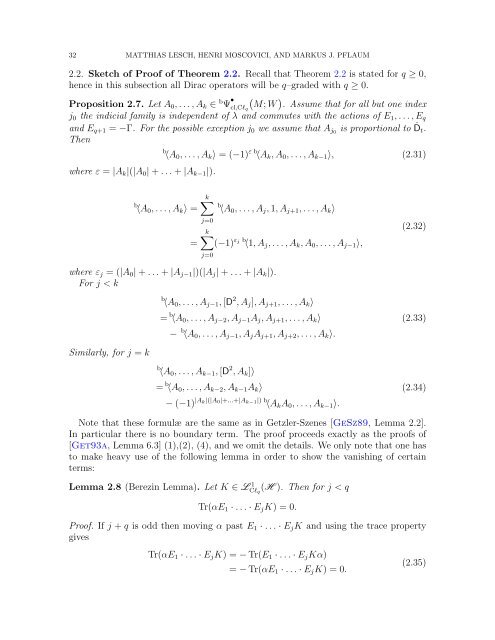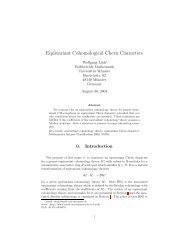Connes-Chern Character for Manifolds with Boundary and ETA ...
Connes-Chern Character for Manifolds with Boundary and ETA ...
Connes-Chern Character for Manifolds with Boundary and ETA ...
Create successful ePaper yourself
Turn your PDF publications into a flip-book with our unique Google optimized e-Paper software.
32 MATTHIAS LESCH, HENRI MOSCOVICI, AND MARKUS J. PFLAUM<br />
2.2. Sketch of Proof of Theorem 2.2. Recall that Theorem 2.2 is stated <strong>for</strong> q ≥ 0,<br />
hence in this subsection all Dirac operators will be q–graded <strong>with</strong> q ≥ 0.<br />
Proposition 2.7. Let A 0 , . . . , A k ∈ b Ψ • ( )<br />
cl,Cl q M; W . Assume that <strong>for</strong> all but one index<br />
j 0 the indicial family is independent of λ <strong>and</strong> commutes <strong>with</strong> the actions of E 1 , . . . , E q<br />
<strong>and</strong> E q+1 = −Γ. For the possible exception j 0 we assume that A j0 is proportional to Ḋt.<br />
Then<br />
where ε = |A k |(|A 0 | + . . . + |A k−1 |).<br />
b 〈A 0 , . . . , A k 〉 = (−1) ε b 〈A k , A 0 , . . . , A k−1 〉, (2.31)<br />
b 〈A 0 , . . . , A k 〉 =<br />
=<br />
k∑<br />
b 〈A 0 , . . . , A j , 1, A j+1 , . . . , A k 〉<br />
j=0<br />
k∑<br />
(−1) ε j b 〈1, A j , . . . , A k , A 0 , . . . , A j−1 〉,<br />
j=0<br />
(2.32)<br />
where ε j = (|A 0 | + . . . + |A j−1 |)(|A j | + . . . + |A k |).<br />
For j < k<br />
b 〈A 0 , . . . , A j−1 , [D 2 , A j ], A j+1 , . . . , A k 〉<br />
= b 〈A 0 , . . . , A j−2 , A j−1 A j , A j+1 , . . . , A k 〉<br />
− b 〈A 0 , . . . , A j−1 , A j A j+1 , A j+2 , . . . , A k 〉.<br />
(2.33)<br />
Similarly, <strong>for</strong> j = k<br />
b 〈A 0 , . . . , A k−1 , [D 2 , A k ]〉<br />
= b 〈A 0 , . . . , A k−2 , A k−1 A k 〉<br />
− (−1) |A k|(|A 0 |+...+|A k−1 |) b 〈A k A 0 , . . . , A k−1 〉.<br />
(2.34)<br />
Note that these <strong>for</strong>mulæ are the same as in Getzler-Szenes [GeSz89, Lemma 2.2].<br />
In particular there is no boundary term. The proof proceeds exactly as the proofs of<br />
[Get93a, Lemma 6.3] (1),(2), (4), <strong>and</strong> we omit the details. We only note that one has<br />
to make heavy use of the following lemma in order to show the vanishing of certain<br />
terms:<br />
Lemma 2.8 (Berezin Lemma). Let K ∈ L 1 Cl q<br />
(H ). Then <strong>for</strong> j < q<br />
Tr(αE 1 · . . . · E j K) = 0.<br />
Proof. If j + q is odd then moving α past E 1 · . . . · E j K <strong>and</strong> using the trace property<br />
gives<br />
Tr(αE 1 · . . . · E j K) = − Tr(E 1 · . . . · E j Kα)<br />
= − Tr(αE 1 · . . . · E j K) = 0.<br />
(2.35)

















